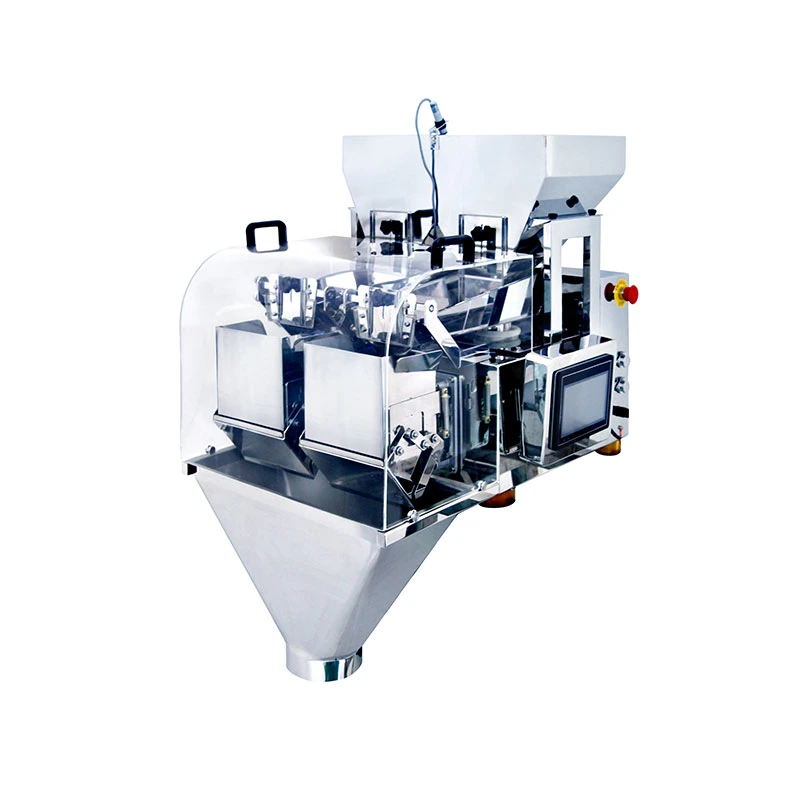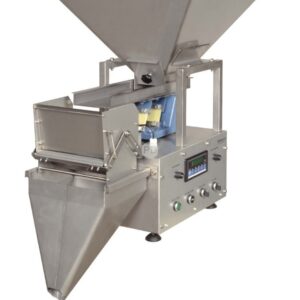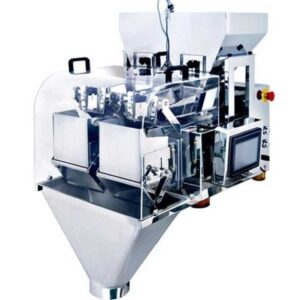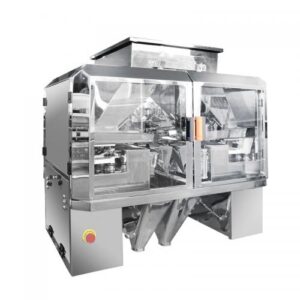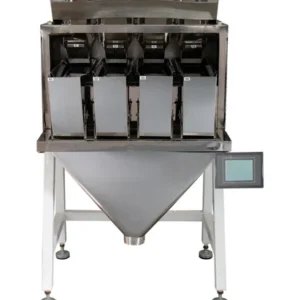Description
| Specification | Details |
|---|---|
| Model | Qualipak ALW-2000 |
| Weighing Range | 10g – 2000g (customizable options available) |
| Accuracy | ±0.5 – 2g (depending on product) |
| Speed | Up to 60 packs per minute |
| Hopper Capacity | 25L |
| Power Supply | 220V, 50Hz |
| Power Consumption | 1.5kW |
| Material | Stainless Steel 304 |
| Display | 7-inch touchscreen display |
| Conveyor Height | Adjustable |
| Dimensions (LxWxH) | 1400mm x 950mm x 1150mm |
| Weight | 300kg |
| Control System | PLC and HMI interface |
| Operating Environment | Temperature: 0-40°C, Humidity: 10-90% |
| Optional Features | Multi-language interface, Remote Monitoring |
Introduction to Automatic Linear Weigher Machines
Automatic Linear Weigher Machines, also known as linear weighing machines or linear weighers are advanced devices designed to accurately measure and dispense predetermined quantities of products for packaging. These machines make use of a linear weighing mechanism where products are transported along the linear conveyor belt system and weighed at different stages before being packaged.
Working Process
The working process of an Automatic Linear Weigher Machine includes several key steps:
Product Feeding: The products that require weighing are placed in the machine’s hopper or feeding system which can be done manually or via an automated feed method such as a vibratory feeder.
Distribution: Then, these products are evenly distributed into multiple pans or weighing units that are usually found along a single conveyor belt line.
Weighing: Each pan contains load cells or sensors that measure the weight of the product(s) put on them. These weight measurements are then communicated to the machine control system.
Combination: All the weights measured from each pan together with analysis by the machine software determines the total weight of products panned.
Dispensing: The machine then releases quantities of commodities into packaging containers like bags, pouches, and containers based on pre-programmed parameters of weight.
Feedback Control: Automatic Linear Weigher Machines come with feedback controls that maintain a sense of balance by continuously adjusting their weight parameters so they remain accurate over time.
Operating Process
The operating processes that have been executed using automatic linear weigher machines involve setting up these machines, inputting desired weight parameters, and finally monitoring the packaging process. Below is a brief discussion of such general steps:
Setup: A particular machine is set up according to requirements specific to the products being packaged. It involves choosing how many pans will be used for weighing, adjusting speed per minute for conveyor belts as well as the calibration process for scales used.
Parameter Input: To set targeted weight amounts plus allowable shifting limits (tolerance), one has to key in the respective figures via a touchpad or control panel of this weighing system.
Start-up: Once it’s all set up, this machine is started and products are made to flow into the feeding system/hopper.
Monitoring: To ensure accurate weight dispensation as well as promptness in attending to any issues arising during packaging, the operator must keep an eye on the process of packing.
Maintenance: Several routine tasks ought to be performed regularly including cleaning the machine, inspecting and replacing worn-out parts, and scale recalibration where necessary to maintain the proper functioning of automatic linear weigher machines.
Applications
Automatic Linear Weigher Machines are used across many industries such as:
Food Industry: Weighing and packaging a variety of food items like snacks, sweets, confectionery, cereals, and frozen foods.
Pharmaceutical Industry: These devices can also find applications for accurate measurement/dispensing of drugs like tablets/capsules/ pills into bottles or blister packs.
Chemical Industry: Used for weighing and packaging chemicals, powders, granules, or other bulk materials in bags or containers.
Cosmetics Industry: The same instruments serve in making packages for items like powder cosmetics, creams as well as lotions, or gels which come in jars/tubes/ bottles, etc…
Hardware industry: Commonly involved with hardware products that we put together in bags after weighing them these include nuts/bolts/screws/fasteners amongst others.
Agricultural industry: Products that need packaging may consist of seeds/grains/fertilizers/animal feed among others used for agriculture purposes.
Features and Functions
In such a case, some of their characteristics are highlighted:
Highly Accurate: These units have superior weighing technologies and sensors that ensure utmost precision in weight measurements.
Flexible Arrangement: Multiples of weighing pans can be set up as well as customized to suit various kinds of products shapes and sizes.
Fast and Efficient: This leads to high-speed weighing and packaging, thus increasing production throughput and efficiency significantly.
User-Friendly Interfaces: Hence, it becomes relatively easy for machine operators to get them going or run them through several cycles.
Information Management: The system has built-in data management facilities for keeping records on production metrics like batch records, weight statistics, and error logs.
Auto Rejection: Integrated rejection systems will automatically reject underweight or overweight packages thus ensuring accurate weights of packed products only.
Easily Maintained: Designed to be user-friendly when cleaning, maintaining, or troubleshooting, they minimize downtime by allowing constant use without any breakages.
Can Be Integrated With Other Machines: It also allows integration with other packaging machines e.g. vertical form-fill-seal machines, conveyor systems, and labeling machines among others into one complete package unit for packaging purposes.
Advantages
Thus adopting Automatic Linear Weigher Machines ensures many benefits to both manufacturers and packagers:
Improved Precision: This guarantees that packages are filled with exact amounts avoiding overfilling or under-filling them.
Enhanced Efficiency: It removes any waste from packaging thus reducing the cost of labor while increasing production yield.
Better Productivity: Products can move off fast from the line after being weighed leading to more outputs within a short time for market entry.
Saves Money: There will be no wastage and rework operations because only the required quantities go into each package.
Assurance Of Quality In Packaging: By sorting out issues related to package weights across different items this system ensures quality control is maintained in terms of consistency in package weights and contents.
Machines Expose Robustness: They can function with numerous products and package types and still adapt to changing production requirements.
Follows Regulations: Also, it makes sure that all products are properly labeled and packaged as required by the relevant authorities in charge of product labeling and packaging.
Brand Reputation: Weighing packages accurately will foster a good brand reputation leading to customer satisfaction.
Common Questions
Do you want to know how accurate automatic linear weigher machines are?
These machines usually offer a high degree of precision which is usually measured within grams or even milligrams depending on the nature of the product being weighed.
Can these kinds of systems be used on different types of goods?
Certainly yes, because this equipment comes with a lot of variety configurations for solid, granular, or powder materials among others.
What do users do when their automatic linear weigher machines break?
To maintain good performance, components should be cleaned, calibrated, and inspected regularly. Additionally, wearing out checks plus timely part replacements are advised.
Do Automatic Linear Weigher Machines work for small-scale production?
They are available in different sizes and designs that make them suitable for both small and large-scale production environments.
Can Automatic Linear Weigher Machines be integrated into existing packaging lines?
Yes. These machines can fit seamlessly with other packing equipment including filling machines, sealing machines, and labeling machines to provide an all-round solution to packaging needs.
Is there a need for specialized training to operate Automatic Linear Weigher Machines?
While some basic training may be necessary to familiarize operators with the machine’s operation and maintenance procedures, most of these have user interfaces that can easily be learned by any worker.
How do Automatic Linear Weigher Machines handle different product sizes and shapes?
These can be adjusted to take various products in terms of size, shape, or density accurately weighing them up as well as dispensing them correctly.
Can automatic linear weigher detect underweight or overweight packages?
Surely, numerous types of these come along with built-in systems that reject packs that fall beyond the specified weight limits automatically.
Are Automatic Linear Weigher Machines appropriate for use with hazardous or corrosive materials?
Specialized models of automatic linear weighers have been developed specifically for handling dangerous or corrosive substances with features such as stainless steel construction and sealed enclosures
How long does an automatic linear weigher last on average?
The useful life of this machine will depend on usage level, maintenance practices employed, and environmental conditions among other factors. However, if properly handled it could serve you for quite several years whilst offering reliable and efficient packaging solutions.

